White box Testing – Software Engineering
Last Updated : 25 Feb, 2025
White box testing techniques analyze the internal structures the used data structures, internal design, code structure, and the working of the software rather than just the functionality as in black box testing.
It is also called glass box testing clear box testing or structural testing. White Box Testing is also known as transparent testing or open box testing.
What is White Box Testing
White box testing is a Software Testing Technique that involves testing the internal structure and workings of a Software Application. The tester has access to the source code and uses this knowledge to design test cases that can verify the correctness of the software at the code level.
White box testing is also known as Structural Testing or Code-based Testing, and it is used to test the software’s internal logic, flow, and structure. The tester creates test cases to examine the code paths and logic flows to ensure they meet the specified requirements.
Learn more:– Software Testing | Basics
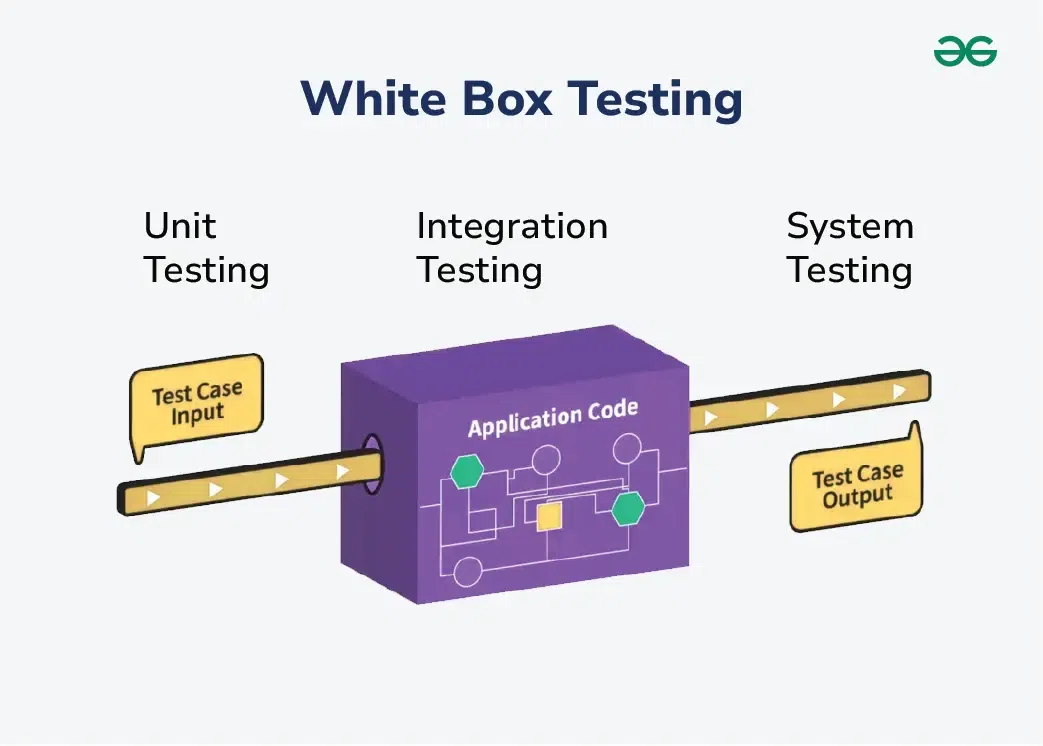
White Box Testing
What Does White Box Testing Focus On?
White box testing include testing a software application with an extend understanding of its internal code and structure. This type of testing allows testers to create detailed test cases based on the application’s design and functionality.
Here are some key types of tests commonly used in white box testing:
- Path Testing: White box testing will be checks all possible execution paths in the program to sure about the each one of the function behaves as expected. It helps verify that all logical conditions in the code are functioning correctly and efficiently with as properly manner, avoiding unnecessary steps with better code reusability.
- Input and Output Validation: By providing different inputs to a function, white box testing check the the function gives the correct output each of the time. This helps to confirm that the software consistently produces the required results under various conditions.
- Security Testing: this will focuses on finding security issues in the code. Tools like static code analysis are used to check the code for potential security flaws, for checking the application for the best practices for secure development.
- Loop testing: It will be check that loops (for or while loops) in the program operate correctly and efficiently. It checks that the loop handles variables correctly and doesn’t cause errors like infinite loops or logic flaws.
- Data Flow Testing: This involves tracking the flow of variables through the program. It ensures that variables are properly declared, initialized, and used in the right places, preventing errors related to incorrect data handling.
Types Of White Box Testing
White box testing can be done for different purposes at different places. There are three main types of White Box testing which is follows:-
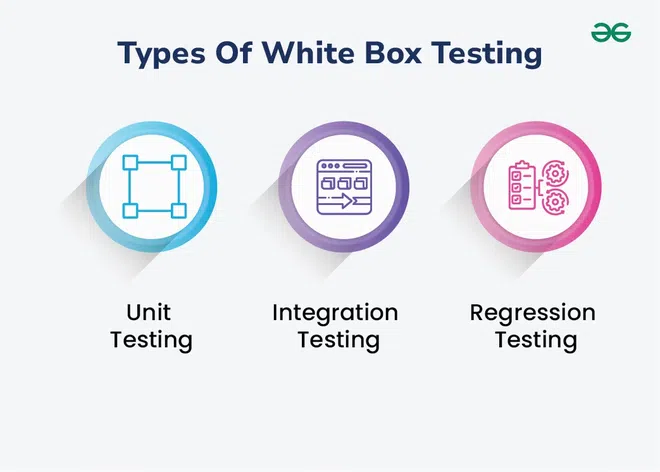
Types Of White Box Testing
- Unit Testing: Unit Testing checks if each part or function of the application works correctly. It will check the application meets design requirements during development.
- Integration Testing: Integration Testing Examines how different parts of the application work together. After unit testing to make sure components work well both alone and together.
- Regression Testing: Regression Testing Verifies that changes or updates don’t break existing functionality of the code. It will check the application still passes all existing tests after updates.
White Box Testing Techniques
One of the main benefits of white box testing is that it allows for testing every part of an application. To achieve complete code coverage, white box testing uses the following techniques:
1. Statement Coverage: In this technique, the aim is to traverse all statements at least once. Hence, each line of code is tested. In the case of a flowchart, every node must be traversed at least once. Since all lines of code are covered, it helps in pointing out faulty code.
If we see in the case of a flowchart, every node must be traversed at least once. Since all lines of code are covered, it helps in pointing out faulty code while detecting.
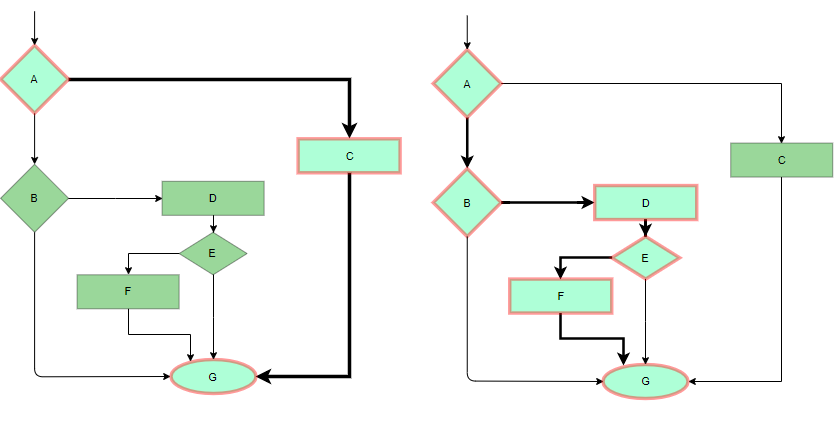
Statement Coverage flowchart
2. Branch Coverage: Branch coverage focuses on testing the decision points or conditional branches in the code. It checks whether both possible outcomes (true and false) of each conditional statement are tested. In this technique, test cases are designed so that each branch from all decision points is traversed at least once. In a flowchart, all edges must be traversed at least once.
In a flowchart, all edges must be traversed at least once.
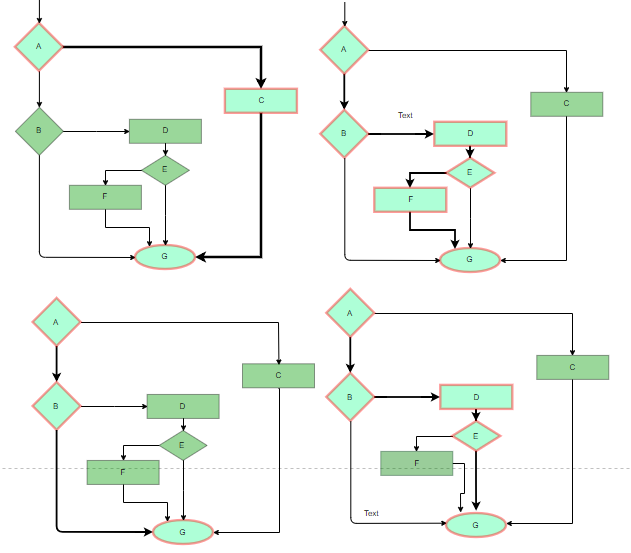
Branch Coverage flowchart
3. Condition Coverage: In this technique, all individual conditions must be covered as shown in the following example:
- READ X, Y
- IF(X == 0 || Y == 0)
- PRINT ‘0’
- #TC1 – X = 0, Y = 55
- #TC2 – X = 5, Y = 0
4. Multiple Condition Coverage: In this technique, all the possible combinations of the possible outcomes of conditions are tested at least once. Let’s consider the following example:
- READ X, Y
- IF(X == 0 || Y == 0)
- PRINT ‘0’
- #TC1: X = 0, Y = 0
- #TC2: X = 0, Y = 5
- #TC3: X = 55, Y = 0
- #TC4: X = 55, Y = 5
5. Basis Path Testing: In this technique, control flow graphs are made from code or flowchart and then Cyclomatic complexity is calculated which defines the number of independent paths so that the minimal number of test cases can be designed for each independent path. Steps:
- Make the corresponding control flow graph
- Calculate the cyclomatic complexity
- Find the independent paths
- Design test cases corresponding to each independent path
- V(G) = P + 1, where P is the number of predicate nodes in the flow graph
- V(G) = E – N + 2, where E is the number of edges and N is the total number of nodes
- V(G) = Number of non-overlapping regions in the graph
- #P1: 1 – 2 – 4 – 7 – 8
- #P2: 1 – 2 – 3 – 5 – 7 – 8
- #P3: 1 – 2 – 3 – 6 – 7 – 8
- #P4: 1 – 2 – 4 – 7 – 1 – . . . – 7 – 8
6. Loop Testing: Loops are widely used and these are fundamental to many algorithms hence, their testing is very important. Errors often occur at the beginnings and ends of loops.
- Simple loops: For simple loops of size n, test cases are designed that:
- Skip the loop entirely
- Only one pass through the loop
- 2 passes
- m passes, where m < n
- n-1 ans n+1 passes
- Nested loops: For nested loops, all the loops are set to their minimum count, and we start from the innermost loop. Simple loop tests are conducted for the innermost loop and this is worked outwards till all the loops have been tested.
- Concatenated loops: Independent loops, one after another. Simple loop tests are applied for each. If they’re not independent, treat them like nesting.
Black Box vs White Box vs Gray Box Testing
In the process of STLC, three primary testing approaches are used which are Black Box Testing, White Box Testing, and Gray Box Testing. Each of these methods are different with the terms of the level of knowledge the tester has about the application and how they approach the testing process.
Here is a simple comparison of them in which highlighting key aspects:
| Aspect | Black Box Testing | White Box Testing | Gray Box Testing |
|---|
| Available Information | Tester has no knowledge of the internal workings including source code and architecture. Focuses on inputs and outputs. | Tester has full knowledge of internal workings, including source code and architecture. | Tester has partial knowledge, such as access to design documents but not the source code. |
| Test Coverage | Limited coverage, based on expected behavior and requirements without internal knowledge. | Full coverage, as tester has access to source code and can test all code paths. | Moderate coverage, with focus on areas where some knowledge is available. |
| Time of Analysis | Performed after the application is built, during later stages of the SDLC. | Can be performed early in the SDLC, integrating into the development process. | Performed after some parts of the application are built but allows for earlier analysis than black box testing. |
| Tool Usage | Uses dynamic analysis tools for testing during runtime, focusing on user behavior. | Uses static analysis tools (like code analyzers) to inspect source code. | Uses both dynamic and limited static analysis tools depending on available knowledge. |
| Tester Mindset | Acts as an end user, focusing on functionality without knowledge of internal workings. | Acts like a developer, focusing on internal logic, structure, and code. | Partially a developer and user, focusing on the expected behavior with some internal knowledge. |
| Test Case Input Size | Largest, as it needs to cover broad user interactions and scenarios. | Smaller compared to black box, as it focuses on specific code paths. | Smaller than both black and white box, focused on available knowledge areas. |
| Finding Hidden Errors | Difficult to detect, as it focuses only on outputs. | Easier due to full access to internal code and logic. | Challenging, may find some hidden errors that are visible at the user level. |
| Algorithm Testing | Not suitable, as it lacks the internal access to algorithms. | Well-suited for testing internal algorithms and logic. | Not suitable, as it lacks full access to algorithms and internal code. |
| Other Names | Functional testing, data-driven testing, closed box testing. | Structural testing, clear box testing, code-based testing, transparent testing. | Translucent testing. |
Process of White Box Testing
White box testing include the verify the internal workings of a software application. It checks that every aspect of the code is tested, basically is focusing on the logic, structure, and flow of the software.
Here’s a breakdown of how this process works:
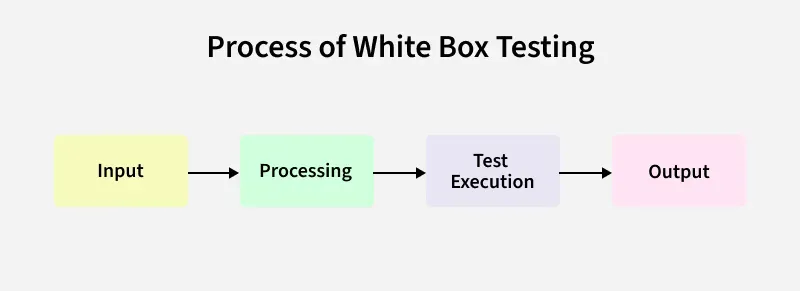
Process of White Box Testing
1. Input: The process starts by combining all the related documents, including:
- Requirements: These outline what the application is supposed to do and its expected behavior.
- Functional Specifications: These describe how the software should perform under specific conditions.
- Design Documents: These provide detailed insights into the architecture, components, and flow of the system.
- Source Code: This is the actual code written for the application. It is where the logic and functionality are defined and is the primary focus during white box testing.
2. Processing: Once the input is combined, the next step is:
- Risk Analysis: This step identifies potential risks in the code. By analyzing the application’s functionality and dependencies, testers can identify areas where errors are more likely to occur and prioritize testing those areas. This helps in making the testing process more focused and efficient for the further process.
- Test Planning: In this stage, testers design detailed test cases that cover all aspects of the code. The aim is to check all paths, conditions, loops, and functions within the code. Test planning ensures that no part of the application is left untested.
3. Test Execution: Now that the test cases are ready to execute and check if any difficulties which we are facing during the same:
- Execute the Tests: The test cases are run to check the behavior of the application. During execution, the application’s internal logic is verified during the same. This includes testing individual functions, loops, and conditions to check that they work as expected.
- Error Identification and Fixing: If errors or bugs are found, they are reported to the development team. The development team fixes the errors, and the tests are again run to verify the fixes. This cycle continues until the software is free from critical issues.
- Results Communication: within the process of testing, the results are documented and communicated to all stakeholders to re-sure everyone is informed of the software’s progress.
4. Output: Once testing is completed with all error solving then these is the final step which we are performing:
- Final Report: A detailed report is prepared that includes all findings, test case results, error logs, and improvements made in the proper format which is easily understandable. This report documented as a record of the testing process and provides an complete overview of the software’s quality. It is typically shared with the development team and other related stakeholders and members.
In white-box testing, the tester must to understand the application’s code and write test cases to validate specific parts of it with checking all the function of the software. Then they can execute these tests, identify any issues, and check the software works correctly as expected.
White box testing, also known as clear box or structural testing, involves examining the internal workings of an application to ensure its functionality and security. In 2025, several tools have used for this process. Here are few white box testing tools:
- SonarQube
- Veracode
- OWASP Code Pulse
- JaCoCo
- PVS-Studio
- Checkmarx
- Coverity
- Klocwork
- CodeClimate
- Codacy
These tools help developers to perform detailed analysis on the source code, checking that all potential issues are detected and addressed early in the development cycle.
Features of White box Testing
- Code coverage analysis: White box testing helps to analyze the code coverage of an application, which helps to identify the areas of the code that are not being tested.
- Access to the source code: White box testing requires access to the application’s source code, which makes it possible to test individual functions, methods, and modules.
- Knowledge of programming languages: Testers performing white box testing must have knowledge of programming languages like Java, C++, Python, and PHP to understand the code structure and write tests.
- Identifying logical errors: White box testing helps to identify logical errors in the code, such as infinite loops or incorrect conditional statements.
- Integration testing: White box testing is useful for integration testing, as it allows testers to verify that the different components of an application are working together as expected.
- Unit testing: White box testing is also used for unit testing, which involves testing individual units of code to ensure that they are working correctly.
- Optimization of code: White box testing can help to optimize the code by identifying any performance issues, redundant code, or other areas that can be improved.
- Security testing: White box testing can also be used for security testing, as it allows testers to identify any vulnerabilities in the application’s code.
- Verification of Design: It verifies that the software’s internal design is implemented in accordance with the designated design documents.
- Check for Accurate Code: It verifies that the code operates in accordance with the guidelines and specifications.
- Identifying Coding Mistakes: It finds and fix programming flaws in your code, including syntactic and logical errors.
- Path Examination: It ensures that each possible path of code execution is explored and test various iterations of the code.
- Determining the Dead Code: It finds and remove any code that isn’t used when the program is running normally (dead code).
Advantages of White Box Testing
- Thorough Testing: White box testing is thorough as the entire code and structures are tested.
- Code Optimization: It results in the optimization of code removing errors and helps in removing extra lines of code.
- Early Detection of Defects: It can start at an earlier stage as it doesn’t require any interface as in the case of black box testing.
- Integration with SDLC: White box testing can be easily started in Software Development Life Cycle.
- Detection of Complex Defects: Testers can identify defects that cannot be detected through other testing techniques.
- Comprehensive Test Cases: Testers can create more comprehensive and effective test cases that cover all code paths.
Disadvantages of White Box Testing
- Programming Knowledge and Source Code Access: Testers need to have programming knowledge and access to the source code to perform tests.
- Overemphasis on Internal Workings: Testers may focus too much on the internal workings of the software and may miss external issues.
- Bias in Testing: Testers may have a biased view of the software since they are familiar with its internal workings.
- Test Case Overhead: Redesigning code and rewriting code needs test cases to be written again.
- Dependency on Tester Expertise: Testers are required to have in-depth knowledge of the code and programming language as opposed to black-box testing.
- Inability to Detect Missing Functionalities: Missing functionalities cannot be detected as the code that exists is tested.
- Increased Production Errors: High chances of errors in production.
Conclusion
White box testing checks the internal code and logic of software to re-sure it to works properly and is optimized. It includes unit testing, integration testing, and regression testing, using methods like statement and branch coverage. While it helps catch defects early and improve performance, it requires knowledge of programming to understand issues related to the software’s external behavior.
Similar Reads
Software Testing Tutorial
Software Testing is an important part of the Development of Software, in which it checks the software works expected with the help of Software testing techniques. And in this Tutorial, we will see the important parts of the Software testing topics which we are discussing here in detail. For those wh
8 min read
What is Software Testing?
Software testing is an important process in the Software Development Lifecycle(SDLC). It involves verifying and validating that a Software Application is free of bugs, meets the technical requirements set by its Design and Development, and satisfies user requirements efficiently and effectively. Her
11 min read
Principles of Software testing - Software Testing
Software testing is an important aspect of software development, ensuring that applications function correctly and meet user expectations. In this article, we will go into the principles of software testing, exploring key concepts and methodologies to enhance product quality. From test planning to e
10 min read
Software Development Life Cycle (SDLC)
Software development life cycle (SDLC) is a structured process that is used to design, develop, and test good-quality software. SDLC, or software development life cycle, is a methodology that defines the entire procedure of software development step-by-step. The goal of the SDLC life cycle model is
11 min read
Software Testing Life Cycle (STLC)
The Software Testing Life Cycle (STLC) in which a process to verify whether the Software Quality meets to the expectations or not. STLC is an important process that provides a simple approach to testing through the step-by-step process, which we are discussing here. Software Testing Life Cycle (STLC
7 min read
Types of Software Testing
Software Testing is an important part of the Software Development Lifecycle, which includes many more Types of Software Testing that we are discussing here in detail. Read More: Software Development Life Cycle. Table of Content Different Types of Software Testing1. Manual Testing 2. Automation Testi
15+ min read
Levels of Software Testing
Software Testing is an important part of the Software Development Life Cycle which is help to verify the product is working as expected or not. In SDLC, we used different levels of testing to find bugs and errors. Here we are learning those Levels of Testing in detail. Table of Content What Are the
4 min read
Test Maturity Model - Software Testing
The Test Maturity Model (TMM) in software testing is a framework for assessing the software testing process to improve it. It is based on the Capability Maturity Model(CMM). It was first produced by the Illinois Institute of Technology to assess the maturity of the test processes and to provide targ
8 min read